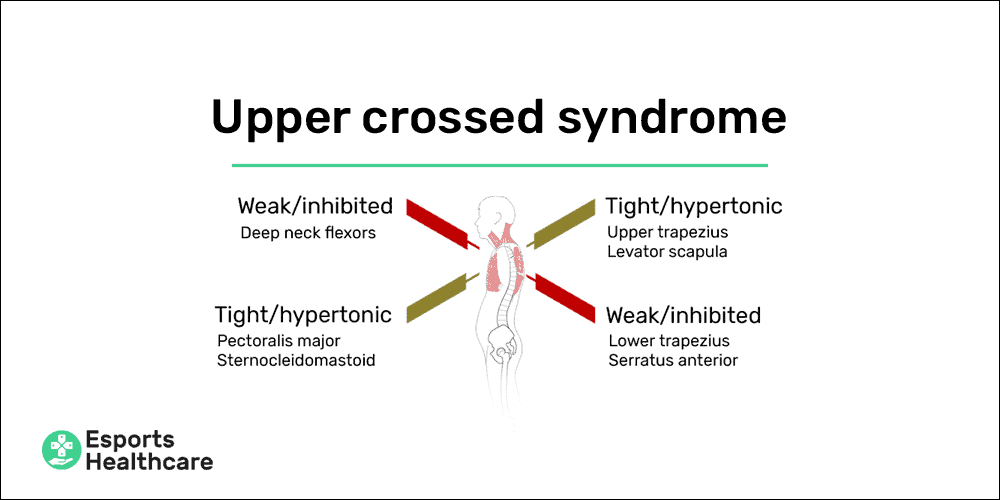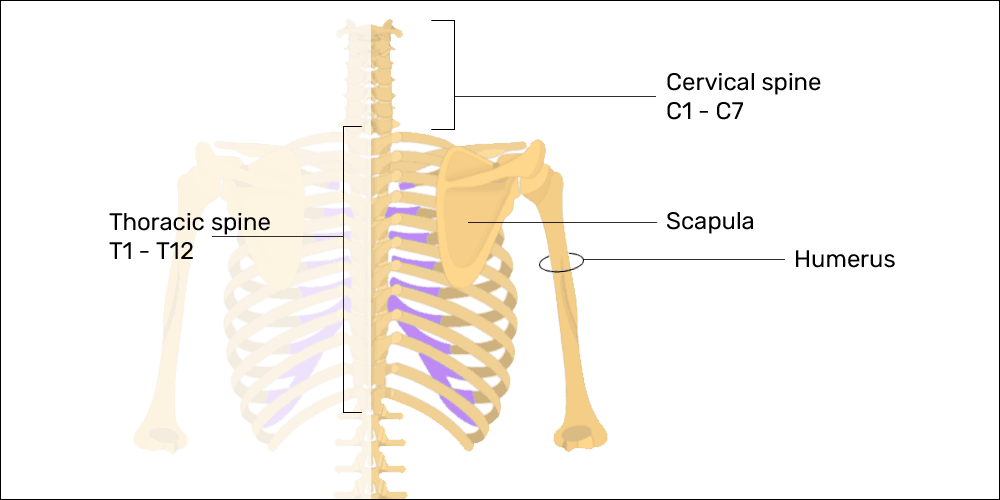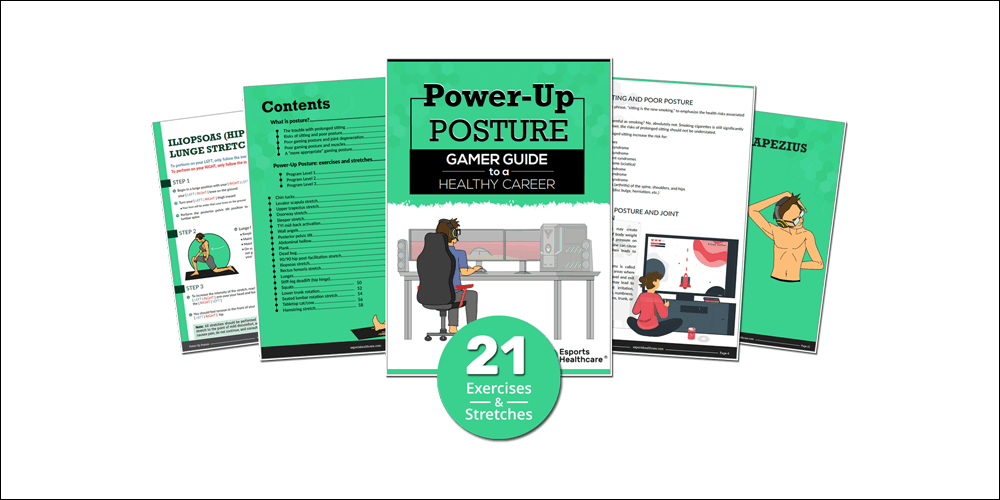Upper crossed syndrome and how sitting will ruin your shoulders

Key points
Disclaimer
This information is for educational purposes only and is not intended to replace the advice of your doctor. Esports Healthcare disclaims any liability for the decisions you make based on this information.
The information contained on this website does not establish, nor does it imply, doctor-patient relationship. Esports Healthcare does not offer this information for diagnostic purposes. A diagnosis must not be assumed based on the information provided.
What is upper crossed syndrome?
Upper crossed syndrome is a postural imbalance that occurs in the muscles of the upper back, scapulae, and shoulder joints. This condition is often a result of prolonged sitting and will be exacerbated by poor posture.
While sitting, some muscles are stuck in a shortened position—a position which begins to take hold. At the same time, other muscles are stuck in a lengthened position, and these muscles become weak or inhibited.
Pertinent anatomy
It’s important to know some basic anatomy of the upper back and shoulders to understand upper crossed syndrome. First, you need to understand some of the bony anatomy (which includes the joints). Then, you can learn the muscles involved and how they are affected.
Bony anatomy
To begin, the bones of the middle and upper back are called the thoracic spine, which is comprised of 12 bones. The bones of the neck, called the cervical spine, are also involved. The cervical spine has 7 bones.
The scapulae are your shoulder blades. The attachment of your arms to the shoulder blades are your shoulder joints, and the shoulder blades are held onto your body by groups of muscles (read below).
Lastly, your ribs, clavicles (collar bones), and sternum (breast bone) are attachment sites for a few muscles involved.

Muscles involved in upper crossed syndrome
Muscles that are affected in upper crossed syndrome include back muscles, neck muscles, and shoulder muscles.
Back muscles
- Upper trapezius: muscles that attach from your shoulder blades to your neck and skull; these are the muscles at the top of your shoulders most commonly involved in shrugging
- Lower trapezius: the antagonist to the upper trapezius, these muscles pull your shoulder blades downward
- Serratus anterior: these muscles stabilize your shoulder blade; they separate (protract) your shoulder blades and hold them flush against your ribs
Neck muscles
- Levator scapula: muscles that attach from your shoulder blades to your neck; these are smaller muscles that are also involved in shrugging
- Sternocleidomastoid: a two-part muscle that attaches from your skull to your collar bones and sternum; these muscles can turn your head or flex your head/neck (e.g., looking down)
- Deep neck flexors: these muscles stabilize your cervical spine and are primarily involved in a chin-tuck action (pulling your head back over your shoulders)
Shoulder muscles
- Pectoralis major: your chest muscles; these muscles pull your arms in front of you and towards the middle

Pathophysiology
Upper crossed syndrome most often occurs when prolonged poor posture (most often sitting) creates tightness in some muscles and inhibition of others.
Tight or hypertonic muscles
Many people have a tendency to sit or stand with their shoulders rounded forward and their head and neck looking downward.
In this position, the pectoralis major and sternocleidomastoid muscles described above are shortened from the forward rounding position.
At the same time, the shoulder blades tend to be shrugged, creating shortness in the upper trapezius and levator scapulae muscles. Over time, the muscles begin to hold in this shortened position.
This response to shortening is described as chronic hypertonicity. A hypertonic muscle is one that has an unconscious, partial contraction. A hypertonic muscle will also have resistance to stretching due to this low-grade contraction.
The tight or hypertonic muscles in upper crossed syndrome include:
- Pectoralis major
- Sternocleidomastoid
- Upper trapezius
- Levator scapula
These tight muscles will pull on the bones to which they attach, even when you’re not sitting or standing with poor posture.
Weak or inhibited muscles
While in this rounded position, some muscles are significantly less active. Over time, the prolonged decrease in activity combined with the antagonist muscle tightness creates long-term weakness or inhibition of the following muscles or muscle groups:
- Lower trapezius
- Serratus anterior
- Deep neck flexors

Muscle imbalance
Tightness of the pectoralis major, sternocleidomastoid, upper trapezius, and levator scapula along with weakness/inhibition of the lower trapezius, deep neck flexors, and serratus anterior creates a postural imbalance in the upper back, neck, and shoulders.
The postural imbalance noted in upper crossed syndrome is a forward rotation and shrugging of the shoulders with a forward leaning position of the head and neck.
Signs and symptoms
As a postural imbalance, upper crossed syndrome does not necessarily present with pain or other symptoms. The signs of upper crossed syndrome are the same details as described in Pathophysiology.
- Muscular imbalance
- Tight or hypertonic: pectoralis major, sternocleidomastoid, upper trapezius, levator scapula
- Weak or inhibited: lower trapezius, deep neck flexors, serratus anterior
- Postural imbalance
- Forward rounded shoulders: the shoulder joints will be pulled forward and inward
- Shrugged shoulders: the shoulder blades will be elevated
- Anterior head carriage: the mid-back, head and neck will be flexed forward, and the head will not be flush over the shoulder joints
- Other symptoms may include
- Neck pain
- Shoulder pain
- Decreased range of motion of the shoulders, mid-back, and neck
- Feeling tightness or discomfort with shoulder or neck movements
Common mechanism of injury
The primary mechanism for the onset of upper crossed syndrome is simple and straightforward. Prolonged poor posture, most often from sitting, will lead to the muscular imbalance.

Prevention and rehabilitation
Likewise to the mechanism, prevention is simple and straightforward. First and foremost, check your posture, and avoid prolonged sitting by taking breaks.
However, there are other preventative measures to reduce your risk of developing upper crossed syndrome if you are stuck in a seated position for many hours per day.
Sometimes, a simple reminder can help to keep your body in a better position. However, prolonged sitting—especially in a poor position—will create the muscular imbalances described earlier.
When this happens, simply thinking about sitting more appropriately may still be ineffective. So, we developed Power-Up Posture with 21 exercises and stretches to help improve your posture.

Power-Up Posture: gamer guide to a healthy career
Power-Up Posture is an exercise and stretch program designed to counter the ill-effects of prolonged sitting. The program is effective for both prevention and rehabilitation of upper crossed syndrome.
Power-Up Posture is a comprehensive program to stretch and relax the hypertonic muscles and to stimulate activation and strengthening of the inhibited muscles affected in upper crossed syndrome.
Through participation of this program, you can effectively prevent these muscular imbalances and reduce pain associated with prolonged sitting and poor posture.
